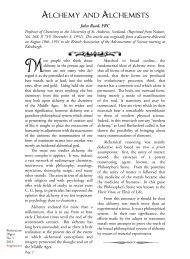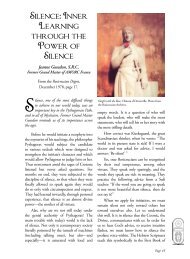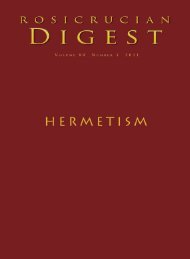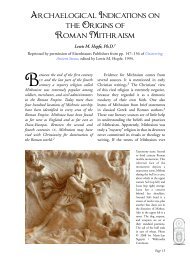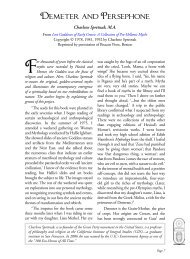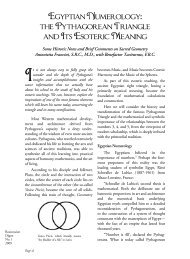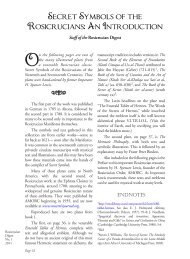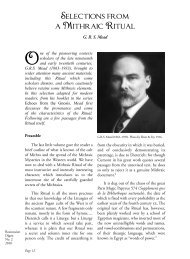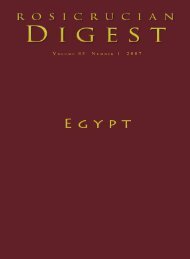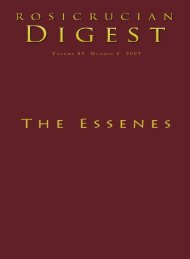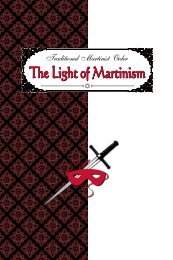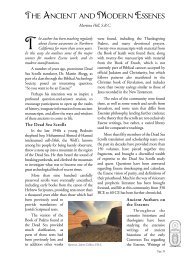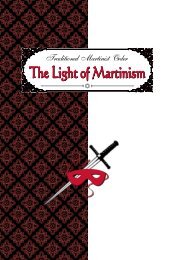The Grand Temple - Rosicrucian Order, AMORC
The Grand Temple - Rosicrucian Order, AMORC
The Grand Temple - Rosicrucian Order, AMORC
Create successful ePaper yourself
Turn your PDF publications into a flip-book with our unique Google optimized e-Paper software.
ody, to its universal origin or loving source.<br />
<strong>The</strong> Eleusinian initiations were presented in<br />
three stages: the minor expression; the major<br />
expression (lasting nine days); and the highest<br />
of the three—the epopteia (meaning “the<br />
state of having seen”). <strong>The</strong>se Mysteries were<br />
so important that during antiquity the whole<br />
Greek world held a fifty-five-day truce to permit<br />
travel to and from Eleusis. <strong>The</strong> progressive<br />
concept of initiation and its effect on the<br />
individual is continued in <strong>Rosicrucian</strong> Initiation.<br />
Isis Mysteries<br />
(4th century BCE to 6th century CE)<br />
As the Hellenized Egyptian mysteries of Isis<br />
spread throughout the Mediterranean world,<br />
from the Middle East to Britain, they soon<br />
became one of the most widespread exports of<br />
Egyptian spirituality. Many suggest that the Isis-<br />
Horus pair continues in images of the Virgin and<br />
Child. <strong>The</strong> ancient writers, Apuleius, in his book,<br />
<strong>The</strong> Golden Ass, and Iamblichus in <strong>The</strong> Egyptian<br />
Mysteries, described in detail the rituals of the Isis<br />
Mysteries. <strong>The</strong>se Mysteries addressed the desire<br />
for personal transcendence and salvation, and<br />
presented a powerful image of the protective,<br />
nurturing, and victorious Divine Feminine.<br />
Mithraic Mysteries<br />
(2nd century BCE to 5th century CE)<br />
<strong>The</strong> Mithraic Mysteries were an initiatic<br />
mystery school in which students were gradually<br />
introduced to astronomical truths through<br />
symbol, and how this knowledge could lead the<br />
seeker to union with the power behind all<br />
existence. <strong>The</strong> Mithraic Mysteries included a<br />
series of seven initiations in which the candidates<br />
underwent various trials. This combination of<br />
scientific study, symbolic initiation, and cosmic<br />
union is a feature of <strong>Rosicrucian</strong> work.<br />
Hermetism<br />
(1st century BCE to the present day)<br />
Based on the writings attributed to Hermes<br />
Trismegistus (the Hellenized form of the Egyptian<br />
God, Thoth) the Hermetic tradition was honored<br />
by practitioners of Egyptian, Greco-Roman,<br />
Jewish, Christian, and later Islamic religions, and<br />
many believe it represents a continuity of the<br />
teachings of the Egyptian <strong>Temple</strong>s and Mystery<br />
Schools. Hermetism inspired many Renaissance<br />
mystics and scholars, and modern evolutions of<br />
this tradition are often referred to as Hermeticism.<br />
Hermetism emphasizes the organic connection<br />
of the Divine with the earthly (“As above, so<br />
below”) and points the way of return to the<br />
source of being. <strong>Rosicrucian</strong> philosophy is heir<br />
to the Hermetic tradition.<br />
Gnosticism<br />
(1st century to 14th century CE)<br />
One of the early varieties of the Judeo-<br />
Christian spiritual tradition, the various groups<br />
we call “Gnostics” today emphasized the individual<br />
coming to personal and interior experiential<br />
knowledge (Gnosis) of the transcendent Divine<br />
One which is within the innermost being. This<br />
Gnosis then allows the person to enter into union<br />
with the source of all existence. Persecuted in<br />
the Mediterranean in the 4th-5th centuries CE,<br />
Gnostics continued their spiritual practice, moving<br />
to Eastern Europe, the Middle East, Northern<br />
Italy, and finally Southern France, where they<br />
were driven underground in the 14th century<br />
CE. <strong>The</strong> interior center of knowledge is a familiar<br />
theme that manifests in <strong>Rosicrucian</strong> studies<br />
and practice.<br />
Neo-Platonism<br />
(3rd-6th centuries CE,<br />
influential to the present day)<br />
<strong>The</strong> last flowering of the Classical Greek<br />
philosophical tradition, the Neo-Platonists<br />
synthesized the approaches of Plato, Aristotle,<br />
Pythagoras, and others, addressing the<br />
individual yearning for salvation from a<br />
philosophical viewpoint. Neo-Platonism posits<br />
a single source from which all existence<br />
emanates and with which an individual soul<br />
can be mystically united. This philosophical<br />
school provided ways that the individual could<br />
ascend the ladder of being through theoria—<br />
contemplation of the Divine. Neo-Platonic<br />
approaches have continued to be of tremendous<br />
importance in Jewish, Christian, and Islamic<br />
Mysticism, as well as the esoteric schools,<br />
including <strong>Rosicrucian</strong>ism.<br />
Kabbalah<br />
(from the beginning of Judaism to the present day)<br />
<strong>The</strong> word Kabbalah means “received” or<br />
“received tradition.” At the beginning it was<br />
taught only by word of mouth and in the<br />
greatest secrecy. <strong>The</strong> primary books that make<br />
up the foundational writings of Kabbalah<br />
include a meditation manual called the Sepher<br />
Yezirah, or “Book of Formation,” whose first<br />
date of appearance in written form is unknown,<br />
and whose oral teachings date from before the<br />
Page 5




